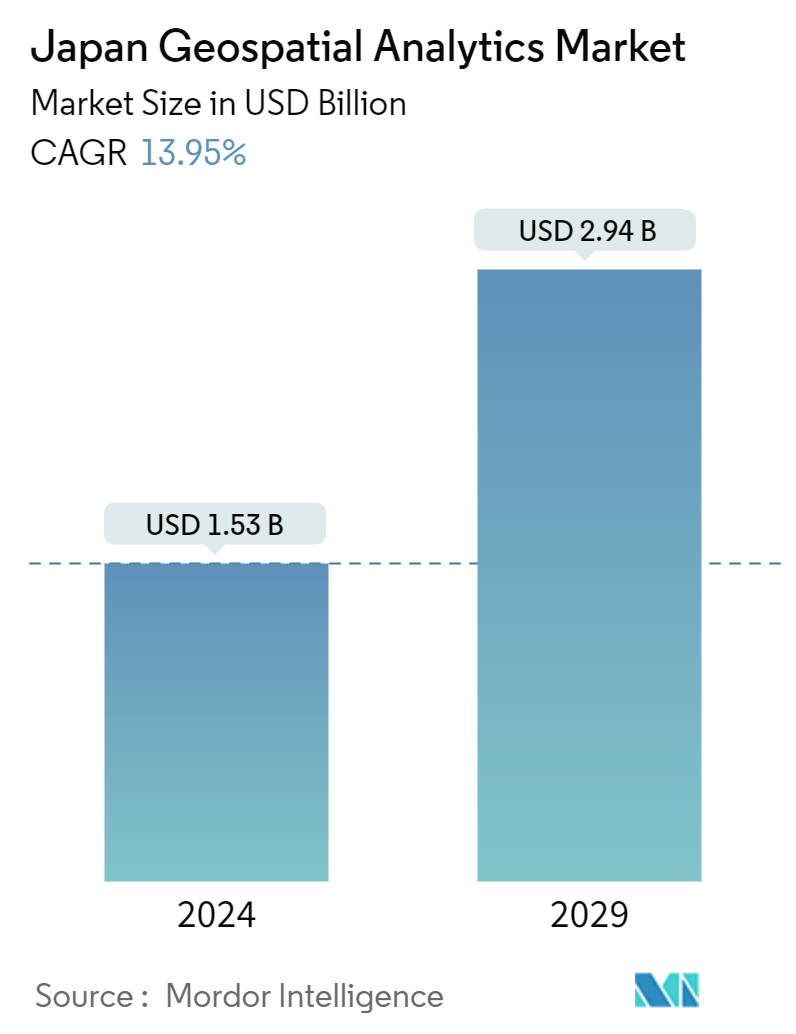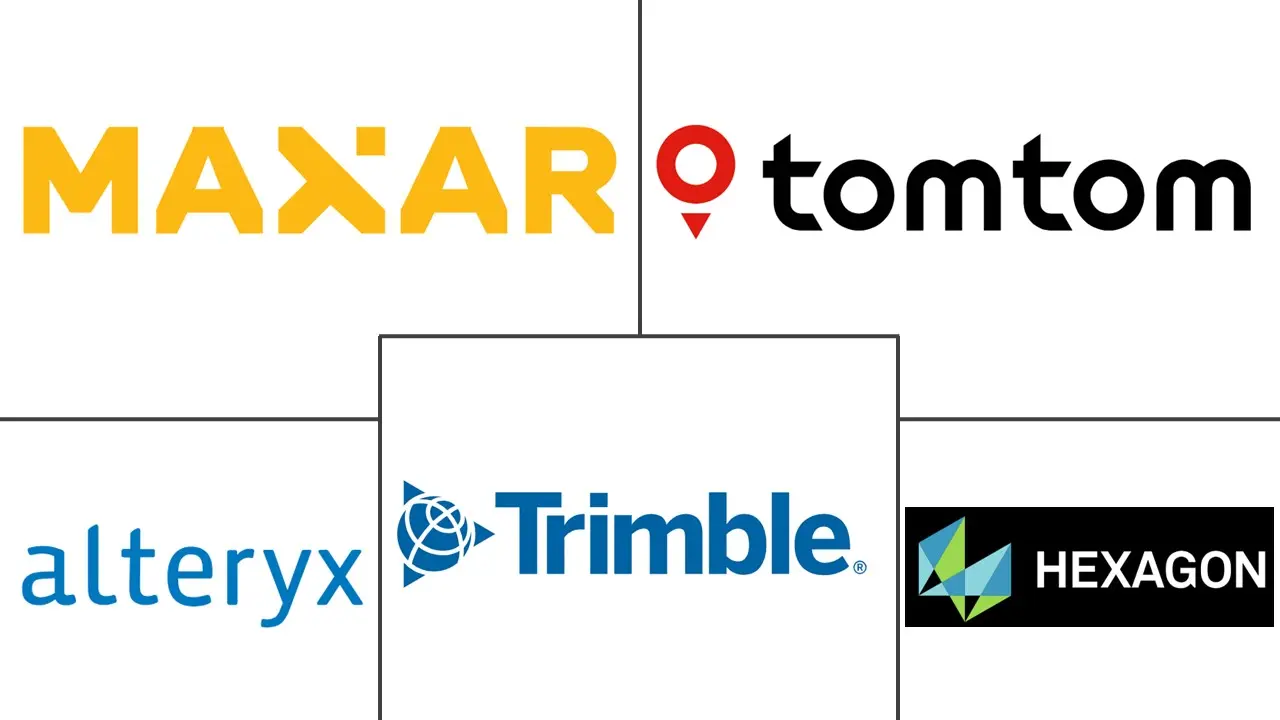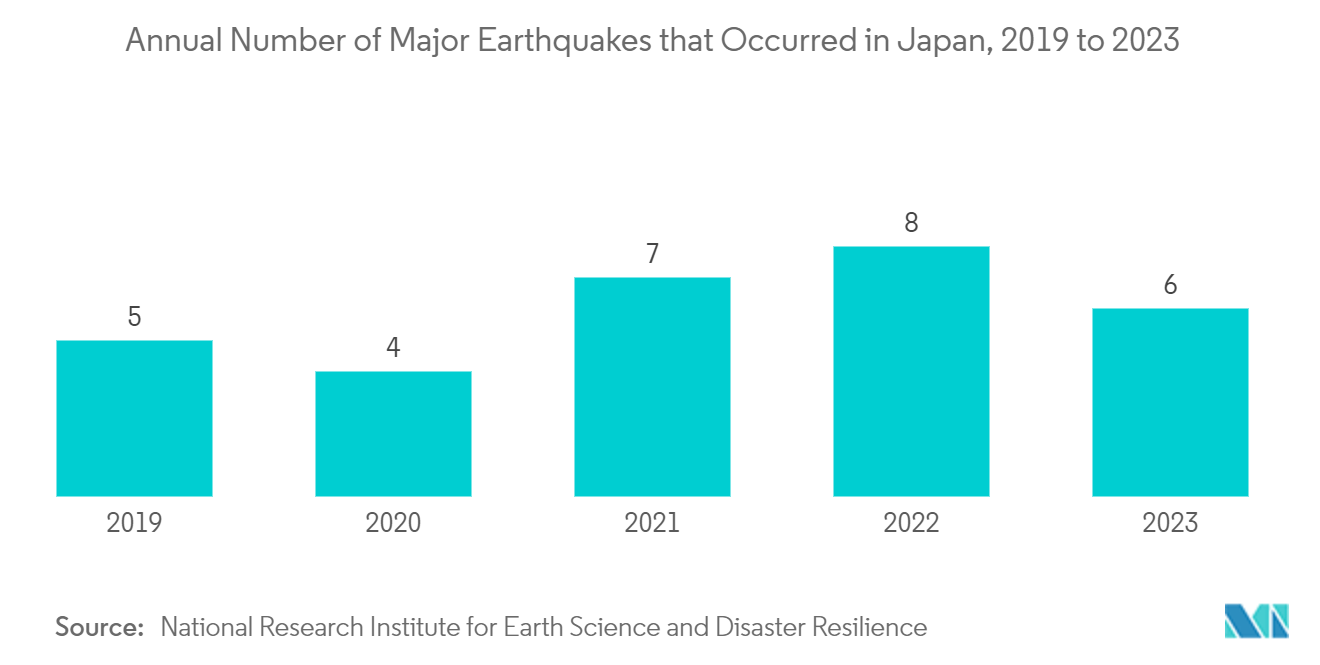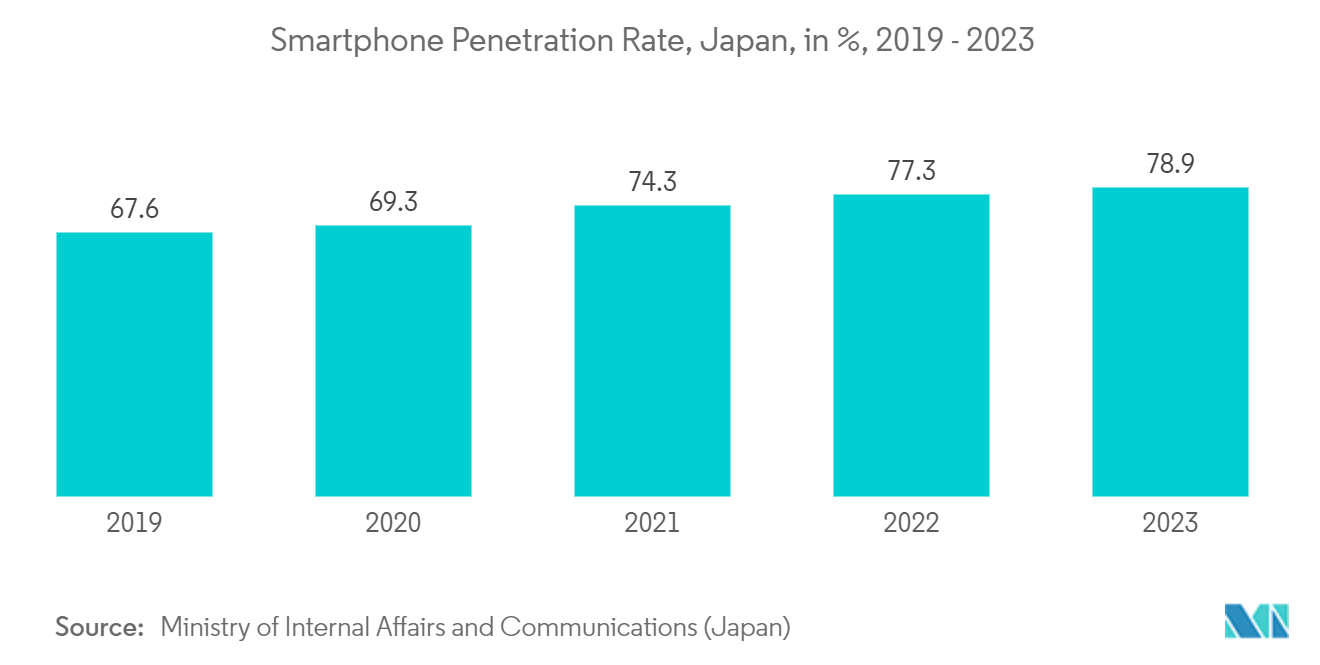Japan Geospatial Analytics Market Size

| Study Period | 2019 - 2029 |
| Base Year For Estimation | 2023 |
| Market Size (2024) | USD 1.53 Billion |
| Market Size (2029) | USD 2.94 Billion |
| CAGR (2024 - 2029) | 13.95 % |
| Market Concentration | Medium |
Major Players
*Disclaimer: Major Players sorted in no particular order |
Japan Geospatial Analytics Market Analysis
The Japan Geospatial Analytics Market size is estimated at USD 1.53 billion in 2024, and is expected to reach USD 2.94 billion by 2029, growing at a CAGR of 13.95% during the forecast period (2024-2029).
- Geospatial analytics is the process of gathering, manipulating, and displaying geographic information system (GIS) data and imagery, including GPS and satellite photographs. The Japanese geospatial analytics market was valued at USD 1.40 billion in the previous year, and it is expected to register a CAGR of 12.69%, reaching USD 2.81 billion by the next five years.
- The Japanese geospatial analytics market is experiencing significant growth due to the increasing adoption of smart city development projects. These initiatives leverage advanced technologies to enhance urban infrastructure, improve public services, and optimize resource management. As cities in Japan integrate geospatial analytics into their planning and operations, they better analyze spatial data, monitor environmental changes, and make informed decisions. This trend is expected to continue driving the market forward, offering numerous opportunities for innovation and investment in the coming years.
- For instance, the Tokyo Smart City Studio, a collaboration between the Georgia Institute of Technology and the University of Tokyo, is a research program that aims to develop a smart and ecologically sound community in Tokyo. The program uses geospatial analytics and other technologies to analyze and visualize urban planning, transportation, energy consumption, and more data.
- Also, the deployment of 5G technology is significantly enhancing the demand and growth of the geospatial analytics market in Japan. With the advent of 5G, the capabilities of geospatial analytics are expanding, offering faster data processing, improved accuracy, and real-time analytics. This technological advancement enables various sectors, including transportation, urban planning, and disaster management, to leverage geospatial data more effectively. As a result, the geospatial analytics market in Japan is experiencing robust growth, driven by the increased adoption of 5G technology.
- In Japan, while several factors propel the geospatial analytics market, high costs and operational challenges are significant constraints that impede its demand and growth. The high costs associated with implementing geospatial analytics solutions, including software, hardware, and skilled personnel, pose a substantial barrier for many organizations. Additionally, operational concerns such as data privacy issues, integration complexities, and the need for continuous updates and maintenance further hinder the market's expansion.
Japan Geospatial Analytics Market Trends
Disaster Risk Reduction and Management
- The increasing frequency and intensity of natural disasters in Japan have necessitated the adoption of advanced geospatial analytics. These tools help predict, prepare for, and mitigate the impacts of such events, thereby enhancing the country's disaster resilience. For instance, geospatial analytics can model potential disaster scenarios, allowing authorities to develop more effective evacuation plans and resource allocation strategies.
- Also, government initiatives and policies aimed at disaster risk reduction significantly contribute to the growth of the geospatial analytics market. The Japanese government has been investing in advanced technologies to improve disaster management strategies, which drives the demand for geospatial analytics. Programs such as the National Resilience Program and the Basic Plan for Disaster Risk Reduction emphasize the integration of geospatial data to enhance disaster preparedness and response.
- Also, the integration of geospatial analytics with other technologies, such as artificial intelligence and big data, is creating new opportunities for innovation in disaster management. This integration allows for more accurate and timely data analysis, crucial for effective disaster response and recovery. For example, AI algorithms are used to analyze geospatial data to predict the path of a typhoon, enabling quicker and more precise emergency responses.
- In September 2023, Higashihiroshima City, located in the Hiroshima Prefecture of Japan, launched an advanced web GIS application for flood hazard and disaster prevention. This platform, powered by the TatukGIS developer kernel (DK) for ASP.NET, is engineered to assess flood risks associated with numerous agricultural irrigation reservoirs.

Growing Demand for Location-based Services
- Location-based services (LBS) have become increasingly popular in Japan, contributing significantly to the expansion of the geospatial analytics market. These services utilize real-time geographical data to provide information, entertainment, and security, enhancing user experience and operational efficiency. The integration of LBS in various applications, such as navigation, social networking, and mobile marketing, has led to a surge in demand for geospatial analytics solutions.
- Moreover, technological advancements have played a crucial role in the proliferation of location-based services. The widespread adoption of smartphones and the development of high-speed internet infrastructure have made it easier for consumers and businesses to access and utilize LBS. In 2023, smartphone ownership in Japan surged to nearly 79%, marking a substantial rise from the mid-2010s. This technological progress has enabled more precise and reliable geospatial data collection, further boosting the geospatial analytics market in Japan.
- Additionally, the Japanese government has been actively promoting the use of geospatial information for various public services and urban planning initiatives. Government policies and investments to improve geospatial data infrastructure have created a favorable environment for the growth of the geospatial analytics market. These initiatives are expected to drive further innovation and adoption of geospatial technologies across different sectors.
- Also, the increasing use of geospatial analytics in transportation, logistics, and retail industries contributes to market growth. Companies in these sectors are leveraging geospatial data to optimize routes, manage assets, and enhance customer experiences. Analyzing and visualizing spatial data provides valuable insights that help businesses make informed decisions and improve operational efficiency.

Japan Geospatial Analytics Industry Overview
The Japanese geospatial analytics market, dominated by major players like Hexagon AB, is witnessing a trend toward consolidation. These key players are strategically partnering and acquiring to fortify their market presence. Simultaneously, they innovate, roll out new applications, and focus on R&D to craft advanced geospatial tools. These tools are tailored for diverse sectors, spanning urban planning, disaster management, and environmental monitoring. Such initiatives are poised to propel market growth in the coming years.
In January 2024, AWS announced plans to invest JPY 2.26 trillion (USD 15.24 billion) in Japan by 2027 to expand cloud computing infrastructure in the country. In addition to expanding its facilities in Tokyo and Osaka, AWS planned to help Japan unlock its cloud potential by addressing the digital skills gap through AWS education programs, training, and certification.
Japan Geospatial Analytics Market Leaders
-
Alteryx
-
Hexagon AB
-
TomTom International BV.
-
Trimble Inc.
-
Maxar Technologies
*Disclaimer: Major Players sorted in no particular order

Japan Geospatial Analytics Market News
- April 2024: Microsoft announced a significant investment of USD 2.9 billion over the next two years to enhance its hyperscale cloud computing and AI infrastructure in Japan. The company will also expand its digital skilling programs to provide AI training to over 3 million individuals within the next three years.
- May 2024: The European Union and Japan began their Digital Partnership, reviewing the progress made since the first Digital Partnership Council in 2023. The partners agreed on new deliverables to enhance cooperation on critical digital technologies. These include artificial intelligence (AI), 5G to 6G advancements, semiconductors, high-performance computing (HPC), quantum technology, submarine cables, eID, and cybersecurity.
- *These technological advancements are poised to drive the evolution of geospatial analytics tools and technologies.
Japan Geospatial Analytics Market Report - Table of Contents
1. INTRODUCTION
1.1 Study Assumptions and Market Definition
1.2 Scope of the Study
2. EXECUTIVE SUMMARY
3. RESEARCH METHODOLOGY
4. MARKET INSIGHTS
4.1 Market Overview
4.2 Industry Attractiveness - Porter's Five Forces Analysis
4.2.1 Threat of New Entrants
4.2.2 Bargaining Power of Buyers
4.2.3 Bargaining Power of Suppliers
4.2.4 Threat of Substitute Products
4.2.5 Intensity of Competitive Rivalry
4.3 Industry Value Chain Analysis
4.4 Impact of Macroeconomic Factors on Market
5. MARKET DYNAMICS
5.1 Market Drivers
5.1.1 Increase In Adoption of Smart City Development
5.1.2 Introduction of 5G to Boost Market Growth
5.2 Market Restraints
5.2.1 High Costs and Operational Concerns
5.2.2 Legal Hurdles
6. MARKET SEGMENTATION
6.1 By Type
6.1.1 Surface Analysis
6.1.2 Network Analysis
6.1.3 Geovisualization
6.2 By End-user Vertical
6.2.1 Agricultural
6.2.2 Utility and Communication
6.2.3 Defense and Intelligence
6.2.4 Government
6.2.5 Mining and Natural Resources
6.2.6 Automotive and Transportation
6.2.7 Healthcare
6.2.8 Real Estate and Construction
6.2.9 Other End-user Verticals
7. COMPETITIVE LANDSCAPE
7.1 Company Profiles*
7.1.1 Alteryx
7.1.2 Hexagon AB
7.1.3 TomTom
7.1.4 Maxar Technologies
7.1.5 Trimble
7.1.6 ESRI
7.1.7 Caliper Corporation
7.1.8 General Electric
7.1.9 Bentley Systems Co.
7.1.10 Fugro
8. INVESTMENT ANALYSIS
9. MARKET OPPORTUNITIES AND FUTURE TRENDS
Japan Geospatial Analytics Industry Segmentation
Geospatial analytics is acquiring, manipulating, and displaying imagery and data from the geographic information system (GIS), such as satellite photos and GPS data. The specific identifiers of a street address and a zip code are used in geospatial data analytics. They are used to create geographic models and data visualizations for more accurate trend modeling and forecasting.
The scope of the study focuses on the market analysis segmented by type (surface analysis, network analysis, and geovisualization) and end-user vertical (agriculture, utility and communication, defense and intelligence, government, mining and natural resources, automotive and transportation, healthcare, real estate, and construction). The market sizes and forecasts are provided in terms of value (USD) for all the above segments.
| By Type | |
| Surface Analysis | |
| Network Analysis | |
| Geovisualization |
| By End-user Vertical | |
| Agricultural | |
| Utility and Communication | |
| Defense and Intelligence | |
| Government | |
| Mining and Natural Resources | |
| Automotive and Transportation | |
| Healthcare | |
| Real Estate and Construction | |
| Other End-user Verticals |
Japan Geospatial Analytics Market Research FAQs
How big is the Japan Geospatial Analytics Market?
The Japan Geospatial Analytics Market size is expected to reach USD 1.53 billion in 2024 and grow at a CAGR of 13.95% to reach USD 2.94 billion by 2029.
What is the current Japan Geospatial Analytics Market size?
In 2024, the Japan Geospatial Analytics Market size is expected to reach USD 1.53 billion.
Who are the key players in Japan Geospatial Analytics Market?
Alteryx, Hexagon AB, TomTom International BV., Trimble Inc. and Maxar Technologies are the major companies operating in the Japan Geospatial Analytics Market.
What years does this Japan Geospatial Analytics Market cover, and what was the market size in 2023?
In 2023, the Japan Geospatial Analytics Market size was estimated at USD 1.32 billion. The report covers the Japan Geospatial Analytics Market historical market size for years: 2019, 2020, 2021, 2022 and 2023. The report also forecasts the Japan Geospatial Analytics Market size for years: 2024, 2025, 2026, 2027, 2028 and 2029.
Japan Geospatial Analytics Industry Report
Statistics for the 2024 Japan Geospatial Analytics market share, size and revenue growth rate, created by Mordor Intelligence™ Industry Reports. Japan Geospatial Analytics analysis includes a market forecast outlook for 2024 to 2029 and historical overview. Get a sample of this industry analysis as a free report PDF download.



